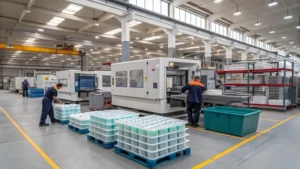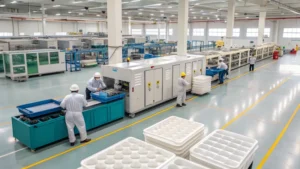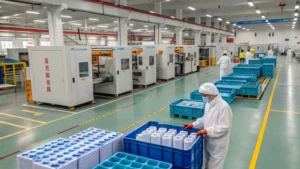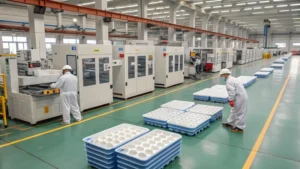
3D printing, particularly through extrusion-based techniques like Fused Deposition Modeling (FDM)1, is transforming the way complex extrusions are created by building objects layer by layer. Unlike traditional extrusion, which pushes material through a die to form uniform shapes, 3D printing allows for intricate, non-uniform designs that meet specific needs. This technology is making waves in industries such as automotive, construction, and food, producing lightweight, customized, and optimized parts.
3D printing creates complex extrusions by extruding material layer by layer, enabling intricate designs beyond traditional methods, used in automotive, construction, and food industries for lightweight, customized parts.
Understanding how 3D printing is applied to complex extrusions can unlock its potential for your projects. This blog explores the materials, processes, applications, and advantages of this innovative technology.
3D printing reduces material waste in manufacturing.True
By building objects layer by layer, 3D printing minimizes waste compared to subtractive methods like milling or cutting.
3D printing is only used for prototyping.False
Beyond prototyping, 3D printing produces end-use parts in industries like automotive and construction.
- 1. What Are the Common Materials Used in 3D Printing for Complex Extrusions?
- 2. What Are the Steps in the 3D Printing Process for Complex Extrusions?
- 3. What Are the Three Key Factors in the 3D Printing Process for Complex Extrusions?
- 4. What Are the Applications of 3D Printing for Complex Extrusions?
- 5. What Are the Differences Between 3D Printing and Traditional Extrusion?
- 6. Conclusion
What Are the Common Materials Used in 3D Printing for Complex Extrusions?
Materials are the backbone of 3D printing for complex extrusions, enabling industries to create lightweight, durable, and application-specific products.

Common materials include thermoplastics like ABS and PLA2, metals, ceramics, and food-based materials, chosen for their strength, flexibility, and unique properties.
| Material Type | Recommended Layer Height | Notes |
|---|---|---|
| ABS | 0.1 - 0.3 mm | High strength, ideal for functional parts |
| PLA | 0.1 - 0.3 mm | Biodegradable, great for prototyping |
| Metals | 0.05 - 0.2 mm | Requires sintering for strength |
| Food Materials | Varies | Needs specific viscosity for shaping |
Thermoplastics (e.g., ABS, PLA)
Thermoplastics like ABS (Acrylonitrile Butadiene Styrene) and PLA (Polylactic Acid) are staples in FDM printing. ABS is prized for its durability, used in automotive parts like intake manifolds, as seen in the Rodin FZERO hypercar. PLA, being biodegradable, excels in prototyping and eco-friendly applications.

Metals
Metal 3D printing extrudes materials like titanium or steel, followed by sintering to enhance strength. This is critical for aerospace and automotive parts where lightweight, complex designs are essential.
Ceramics
Ceramic pastes are extruded and sintered for high-heat applications, such as aerospace components. The voxeljet case study shows their use in construction formwork.
Food Materials
In food 3D printing, materials like chocolate and purees are extruded into intricate shapes. The 3D food printing3 process demands precise viscosity for culinary creativity and personalized nutrition.
Material choice depends on the desired outcome—strength, sustainability, or aesthetics—making it a critical decision in the process.
ABS is a key material for complex extrusions.True
Its strength and durability make ABS a go-to for functional parts across industries.
All industries can use 3D printing materials effectively.False
Some industries need properties not yet available in 3D printing materials, limiting universal adoption.
What Are the Steps in the 3D Printing Process for Complex Extrusions?
The process of 3D printing complex extrusions is a precise sequence that turns digital designs into physical objects.
The process involves designing a 3D model, slicing it into layers, printing layer by layer, and post-processing, used across automotive, construction, and food industries.
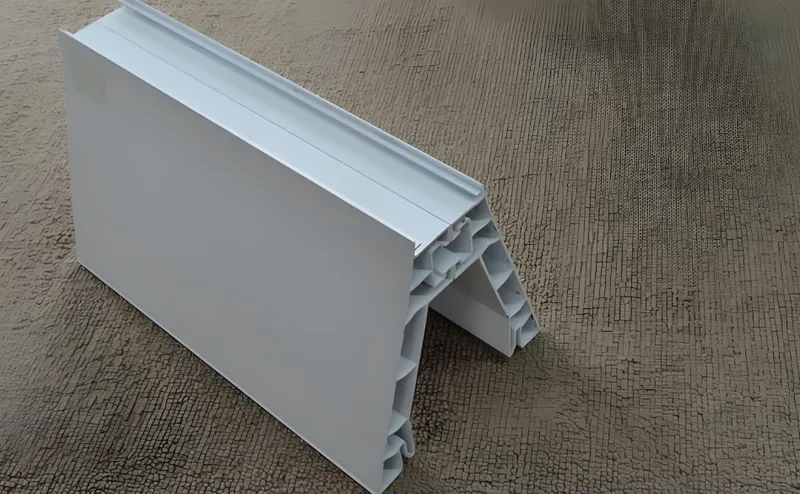
Design
Using CAD software like SolidWorks, engineers design models with complex features like overhangs and internal channels.
Slicing
Slicing software (e.g., Cura or PrusaSlicer) breaks the model into layers, setting parameters like layer height and support structures for the printer.
Printing
The printer extrudes heated material layer by layer, solidifying as it cools. Parameters like nozzle size and temperature are fine-tuned for accuracy.
Post-processing
Parts may need support removal, sanding, or sintering (for metals) to achieve the final form and finish.
3D printing always produces smooth surfaces.False
Surface quality varies with printer settings and often requires post-processing.
3D printing speeds up production of complex parts.True
It eliminates tooling, reducing lead times significantly.
What Are the Three Key Factors in the 3D Printing Process for Complex Extrusions?
Success in 3D printing complex extrusions hinges on three critical elements.
Key factors include material selection4, printer settings, and design optimization, impacting strength, precision, and functionality.

Material Selection
The material dictates the part’s properties. ABS offers durability for automotive use, while PLA suits sustainable prototyping.
Printer Settings
Layer height, speed, and temperature affect quality. Smaller layers enhance detail but slow the process, requiring balance.
Design Optimization
Designs must account for printing constraints, like overhangs needing supports, optimized via tools like Cura.
Material choice defines part performance.True
Each material’s properties directly shape the final product’s capabilities.
All printers use identical settings.False
Settings vary by material and printer, needing customization per job.
What Are the Applications of 3D Printing for Complex Extrusions?
3D printing for complex extrusions shines in diverse industries, delivering tailored solutions.
Applications span automotive parts, construction components, and food designs, boosting efficiency and customization.

Automotive Industry
It creates lightweight parts like brackets and manifolds, as in the Rodin FZERO hypercar.
Construction Industry
Used for intricate formwork and structures, like the MX3D steel bridge.
Food Industry
Shapes detailed food items, enhancing personalization with materials like chocolate.
Biomedical Industry
Produces scaffolds and custom devices using hydrogels for medical advancements.
3D printing cuts material costs.True
Precise material use reduces waste, lowering expenses.
It’s limited to automotive use.False
It extends to construction, food, and biomedical fields too.
What Are the Differences Between 3D Printing and Traditional Extrusion?

Process Flow
3D printing builds layer by layer from a digital file, while traditional extrusion forces material through a die for uniform shapes.
Principle
FDM in 3D printing deposits material selectively; traditional extrusion is a continuous flow process.
Molding Characteristics
3D printing offers design flexibility; traditional extrusion excels at uniform, high-volume output.
Application Scenarios
3D printing suits prototyping and small batches; traditional extrusion is for mass production.
Advantages and Disadvantages
3D printing provides freedom and waste reduction but is slower and costlier for large runs. Traditional extrusion is fast and cheap but less versatile.
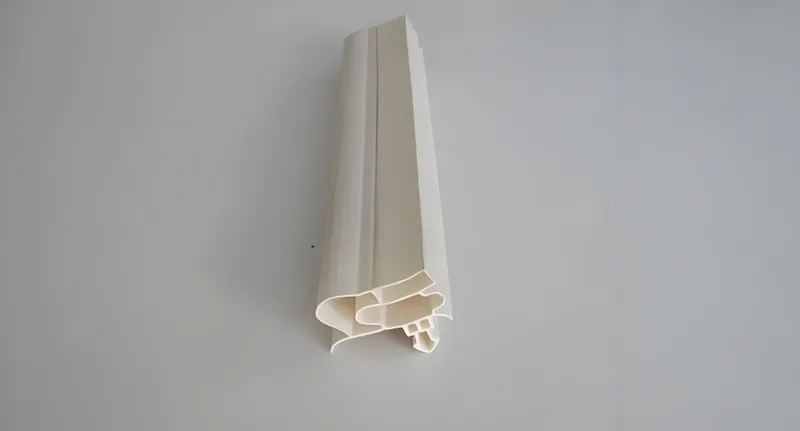
Conclusion
3D printing for complex extrusions is reshaping manufacturing with its ability to craft intricate, customized designs. Using materials like ABS, metals, and food substances, it serves industries from automotive to biomedical. The process—design, slicing, printing, and post-processing—relies on material choice, settings, and design optimization5. While ideal for prototyping and small runs, its limitations in speed and cost make it complementary to traditional methods.
-
Explore this link to understand FDM, a key technology in 3D printing that enables complex designs and applications across various industries. ↩
-
Learn about the advantages of using thermoplastics in 3D printing, including their strength and eco-friendliness, which are crucial for various applications. ↩
-
Discover the innovative world of 3D food printing, where culinary creativity meets technology, allowing for personalized nutrition and unique designs. ↩
-
Learn how material selection influences the quality and properties of 3D printed objects, crucial for successful applications. ↩
-
Discover best practices for design optimization in 3D printing to enhance efficiency and product quality in your projects. ↩

